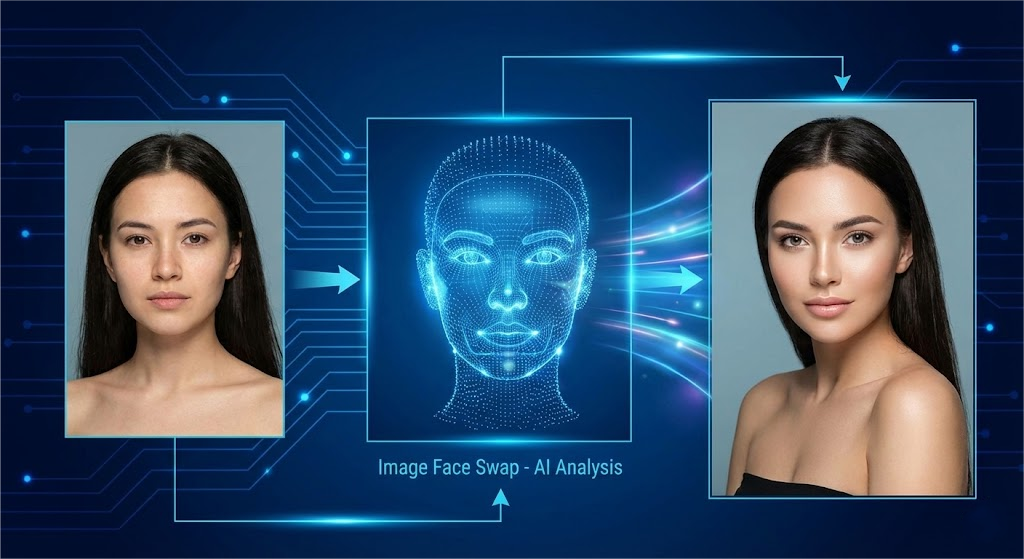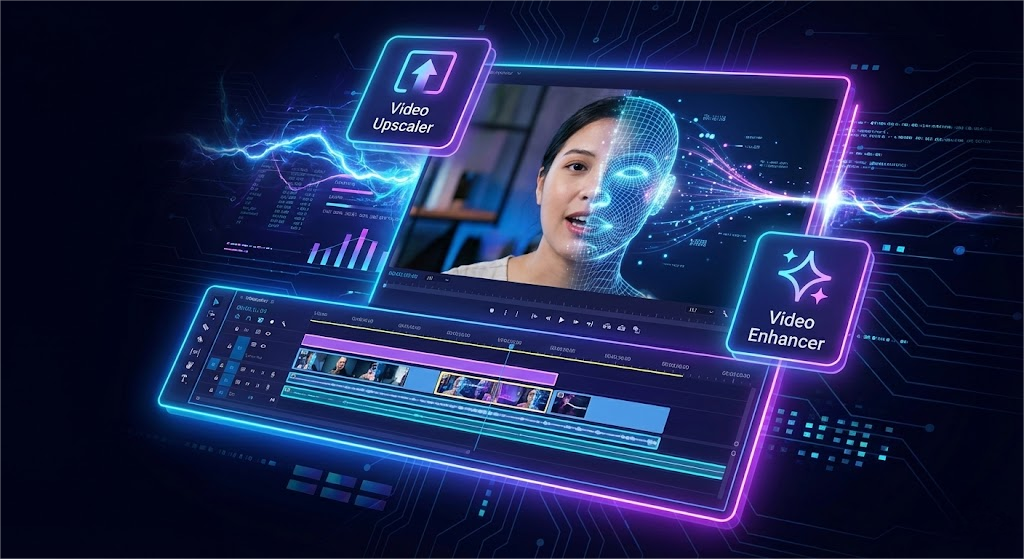The Comprehensive Guide to AI Face Swap Technology: Revolutionizing Digital Creativity with Image and Video Transformation
The advanced AI face swap technology has fundamentally changed the era of digital content creation, enabling creators to seamlessly integrate identity and re conceive visual narrative. No longer limited to high budget Hollywood studios that use complex CGI, now anyone with a browser can use this powerful function. Whether you are a digital marketer seeking content localization, a meme creator aiming at viral transmission, or a professional video editor, it is crucial to understand the AI driven swap mechanism. In this in-depth study, we will explore the subtle differences between image face swap and video face swap, and analyze how neural networks reshape our digital reality. We will also discuss the basic tools attached to these swaps, from the image intensifier function to the voice cloning function, to create perfect professional results.
Mastering Static Reality: The Art and Science of AI Image Face Swap
Although the concept of superimposing one face on another has existed since the early days of photography, modern AI has transformed this manual labor into an automated art form. AI Image face swap is not only a "cut and paste" work; This is a complex algorithm process, generating a GAN to analyze the source and target faces in 3D space. AI recognizes key facial markers, such as the distance between eyes, the curve of lips and the depth of cheekbones, to create a geometric mesh. However, the real magic lies in lighting and texture synthesis. A high-quality photo face swap tool must consider skin color, ambient light direction, and even skin texture to ensure that the results look natural rather than artificial. For example, if you want to replace a face with a retro photo, AI must match the texture and color grading of that particular era. This is where the synergy between swap and enhancement becomes crucial. Generally, the resolution of the source image is low, resulting in blurred results. By using image intensifiers, creators can sharpen the facial features of the source material before the swap occurs, or enhance the final results to 4K quality. This workflow is especially suitable for restoring old family albums or creating professional commercial avatars without organizing physical photography. In addition, the multi-function of image face swap also extends to the field of e-commerce and fashion. Brands can now dynamically change the models in their catalog photos to represent different races without having to re shoot the whole series. This function largely relies on the precise background removal tool to isolate the main body, ensuring that the face swap does not penetrate into the surrounding environment. As we move forward, the boundaries between captured photos and synthetic images continue to blur, making the ability to distinguish between them a problem of checking the perfect details of pixels.

The Dynamic Challenge: Achieving Seamless Video Face Swap
The conversion from static images to dynamic images brings an exponential increase in complexity, making video face swapping a true frontier of generative artificial intelligence. Unlike a single image, a video is a sequence of thousands of frames, and the swapd faces must maintain temporal consistency in each frame. If artificial intelligence cannot track a face even for a fraction of a second, or if the lights flicker, this illusion will be immediately shattered. That's why video face swapping requires much more computing power and complex algorithms than static face swapping.
One of the main obstacles in video swap is dealing with extreme angles and occlusions. When a character turns their head or an object passes in front of them, artificial intelligence must predict what the hidden parts of the face look like. Advanced tools now use video character replacement technology that goes beyond simple facial coverage; They effectively reconstructed the entire head structure to match the lighting environment of the video scene. However, due to processing limitations, the raw outputs of these algorithms are sometimes affected by lower resolutions. This is where video upgraders and video enhancers have become indispensable. These tools perform post-processing on swapd videos, smooth out jitter artifacts, and increase resolution to match modern streaming standards.
In addition, the environment around the subject is equally important as the face itself. Content creators often use video background removers to place their swapd characters in completely new settings, effectively creating a virtual studio. The integration of the VEO 3.1 model further expands the boundaries of possibilities, allowing for high fidelity swap while preserving the microscopic expressions of the original participants. Whether it's imitation, movie dubbing, or privacy protection, mastering video face swapping requires a holistic approach that combines swapping, enhancement, and upgrading into a unified workflow.

Beyond Realism: Creative Expression with GIF Face Swaps and Emotion Control
Although realism is often the goal, the prosperity of the Internet depends on humor, creativity and exaggerated expression. This is where the GIF face swap technology shines, and becomes the main content of social media culture. GIF is a recyclable low bandwidth video that conveys specific emotions. It inserts one's own face or a friend's face into popular culture memes, adding a layer of personalization that words cannot match. Due to the low quality and style of GIF, AI has more room for maneuver, which can achieve faster processing and more interesting and exaggerated results.
However, creativity is not limited to the swap of identities; It also deals with the way identity is manipulated. The innovative tool now includes a facial expression changer that allows users to change the mood of the subject after shooting. Did the subject in the photo frown? Should they smile? AI can adjust the lip curvature and eye extrusion to simulate a real smile. This operation is also extended to audiovisual synchronization. When creating localized content or dubbing videos, it's not enough to just swap faces; The mouth action must match the new soundtrack. Lip synchronization technology analyzes the input audio and makes the mouth of the target face deformed to move in perfect rhythm with the spoken language.
Further, the voice cloning technology allows the creator to synthesize and swap the voice matching the face, so as to create a completely immersive role. Imagine that you use video role replacement to turn yourself into a historical figure in the education video. By using GIF face swap for fast social flirtation, lip sync for conversation accuracy, and clone audio for realism, you are actually playing a person's production studio. These tools democratize high-end visual effects and enable TikTok creators, YouTube users and digital marketers to use them.

The Future of Synthesized Media: Ethics, Quality, and Professional Workflows
As we embrace the capabilities of generative AI, we must also address the professional standards and ethical considerations that come with it. The democratization of face swap technology brings a responsibility to use it transparently and legally. For professionals using these tools for commercial work, ensuring a clean, unbranded final product is crucial. While many free tools leave unsightly watermarks, a professional workflow often requires a watermark remover to ensure the final visual is pristine and ready for broadcast or client delivery. Furthermore, the industry is moving towards "all-in-one" platforms that handle the entire pipeline. A creator might start with a nano banana pro style generation, use video face swap to insert a specific actor, apply voice clone for the dialogue, and finally polish the visuals with an image enhancer. The leading platform facilitating this seamless integration is faceswap-ai.io, which offers a comprehensive suite of tools designed for both novices and professionals. By centralizing these capabilities, it reduces the friction of switching between different apps for swapping, upscaling, and background removal. Looking ahead, the quality of AI generation will continue to skyrocket. We are approaching a point where video background remover algorithms will handle complex hair strands and transparent objects with pixel-perfect accuracy, and video enhancer tools will reconstruct missing details from low-res footage with uncanny precision. Whether you are using photo face swap to create a LinkedIn profile or producing a localized marketing video, the key to success lies in choosing the right toolset that prioritizes data privacy, processing speed, and output fidelity. As the technology matures, those who master the subtle art of combining these AI tools will dominate the digital landscape.
